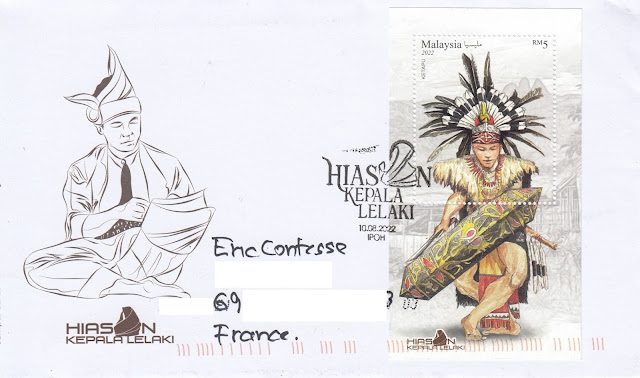Série "Coiffes masculines traditionnelles" sur FDCs de Malaisie
Le 10 août 2022, la poste malaisienne a mis en circulation sa 7ème série
de l'année (4 timbres + 1 bloc-feuillet) consacrée à différents types
de coiffes masculines ("Hiasan Kepala Lelaki" en malais) traditionnelles.
Un grand merci Khor pour l'envoi de ces deux FDCs officiels concernant
respectivement le bloc-feuillet et les 4 timbres de cette jolie série, avec
TADs d'Ipoh (état de Perak) !
A travers cette série, la poste malaisienne a voulu rappeler que ces coiffes ne sont pas que des simples objets de décoration, mais les détails de chacune d'elles ont leur propre signification, fonction et identité. Ces coiffes sont des marqueurs des différents groupes ethniques qui composent la Malaisie.
L'utilisation de la coiffe comprend les cérémonies royales, les cérémonies communautaires locales et commence maintenant à imprégner les styles de mode contemporains.
On August 10, 2022, the Malaysian Post released its 7th series of the year (4 stamps + 1 souvenir sheet) dedicated to different types of traditional men's headgear ("Hiasan Kepala Lelaki" in Malay).
A big thank you Khor for sending these two official FDCs concerning respectively the souvenir sheet and the 4 stamps of this beautiful series, with postmarks from Ipoh (state of Perak)!
Through this series, the Malaysian Post wanted to remind that these headdresses are not just simple decorative objects, but the details of each of them have their own meaning, function and identity. These headdresses are markers of the different ethnic groups that make up Malaysia.
The use of the headdress includes royal ceremonies, local community ceremonies and is now beginning to permeate contemporary fashion styles.
Appartenant au groupe des Dayak, peuple indigène de l'île de Bornéo, les hommes de cette ethnie des Iban sont connus pour leur pratique de la chasse et de la piraterie. Ils étaient jusqu'au 19ème siècle, une grande tribu guerrière de Bornéo.
Aujourd'hui, ils s'urbanisent rapidement autour de Kuching et des grandes villes du Sarawak comme Miri et Sibu, tout en veillant à conserver leur culture et leur héritage traditionnel dans une Malaisie en pleine transformation.
A noter qu'un vernis UV spécial a été appliqué sur la coiffe du personnage représenté sur ce bloc-feuillet.
Parmi les autres coiffes traditionnelles, on trouve le tanjak ou tengkolok, porté par les hommes de la communauté malaise, majoritaire dans le pays. Cette coiffe est couramment utilisée lors de certains évènements importants et célébrations de mariage.
Ketapu, an impressive headgear made of feathers, emblematic of the Iban community living in the state of Sarawak (island of Borneo), is depicted on the souvenir sheet (RM 5) above.
Belonging to the Dayak group, an indigenous people of the island of Borneo, the men of this Iban ethnic group are known for their practice of hunting and piracy. They were until the 19th century, a great warrior tribe of Borneo.
Today, they are rapidly urbanizing around Kuching and major Sarawak cities like Miri and Sibu, while ensuring that their culture and traditional heritage are retained in a rapidly changing Malaysia.
To note that a special UV varnish has been applied to the headdress of the character represented on this souvenir sheet.
Among the other traditional headdresses, we find the tanjak or tengkolok, worn by the men of the Malay community, the majority in the country. This headgear is commonly used in some important events and wedding celebrations.
Le timbre suivant (70 sen) montre une coiffe appelée Tempok, utilisée par les hommes de la tribu Orang Asli, le nom sous lequel, en Malaisie, on désigne les populations indigènes, distinctes des malais et présentes avant l'arrivée de ces derniers dans la péninsule Malaise.
Le 3ème timbre ci-dessus (80 sen) est consacré au Siga, porté par les hommes de l'ethnie des Kadazans, peuplant principalement la région de Penampang sur la côte ouest de l'état de Sabah, ainsi que l'intérieur des terres de Bornéo.
Le dernier timbre ci-dessus (80 sen) représente une coiffe appelée Lavung Tepo/Dok, un des symboles du groupe indigène des Orang Ulu (composé de 27 ethnies distinctes), vivant dans l'état de Sarawak (île de Bornéo).
Made from a long songket folded and tied in a particular style, tanjak is depicted on the first stamp of this series above (70 sen).
The following stamp (70 sen) shows a headgear called Tempok, used by the men of the Orang Asli tribe, the name by which, in Malaysia, we designate the indigenous populations, distinct from the Malays and present before the arrival of the latter in the Malay Peninsula.
The 3rd stamp above (80 sen) is dedicated to Siga, worn by men of the Kadazan ethnic group, mainly inhabiting the Penampang region on the west coast of the state of Sabah, as well as inland Borneo.
The last stamp above (80 sen) is featuring a headdress called Lavung Tepo/Dok, one of the symbols of the indigenous group of Orang Ulu (composed of 27 distinct ethnic groups), living in the state of Sarawak (island of Borneo).


Aucun commentaire:
Enregistrer un commentaire